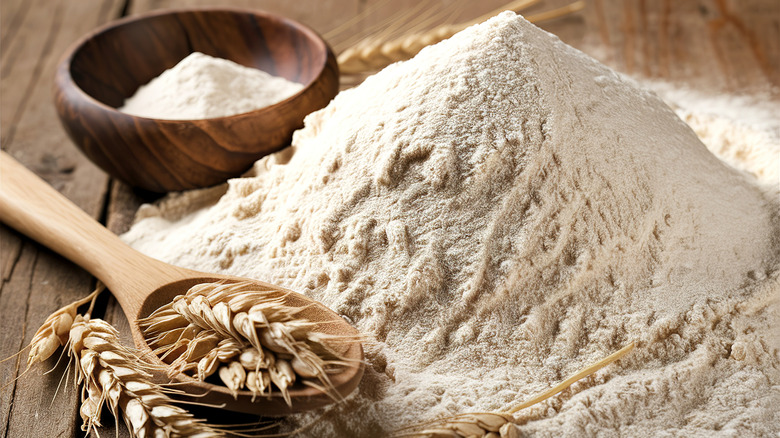The Best And Worst Flours For Focaccia According To An Expert
Making bread from scratch can seem like a daunting task, but luckily, fluffy Italian focaccia is one of the easiest and most fun types to bake at home. It's endlessly customizable (you can even swap out the water in your recipe with marinara sauce for a flavorful twist), but it only requires a few basic core ingredients and a cast iron pan to come together. As with most breads, one of these core ingredients is flour, and using the right type of flour is key to baking a delectable loaf.
Though there is something called bread flour that is particularly suited for hearty loaves, expert Italian chef Luca Corazzina recommends forgoing it and sticking with classic, all-purpose flour. "All-purpose flour creates a light, airy crumb, making it perfect for traditional focaccia," says Corazzina, the Chef de Cuisine at OLIO E PIÙ, an Italian kitchen with outposts in New York City, Chicago, and Washington, D.C.
The other flour that Corazzina recommends using in focaccia is whole-wheat. "Whole wheat flour can add a nutty depth and a denser texture, which is great for a rustic take on this bread," he says.
Avoid flours that don't lead to a proper rise
According to chef Luca Corazzina, the worst flours to use when baking focaccia are "flours like rice flour or semolina, as they don't develop the gluten structure needed for the dough to rise properly," he says. Using these types "can result in a crumbly or overly dense bread," he adds.
Gluten development is one of the main factors that distinguishes between different types of flour, from bread flour to 00 flour and from all-purpose to cake flour. Each of these flours has a different protein content and coarseness, and those higher in protein, like bread flour, develop more gluten and produce stronger, chewier baked goods as a result. Low-protein flours such as cake flour, on the other hand, are useful for baking lighter, airier treats like angel food cake, though many cake recipes do just fine with all-purpose flour instead.
Flours are also differentiated by the size of their grind, which plays an important role in gluten development and in shaping the texture of baked goods. While semolina flour is high in protein, it is particularly coarse, and its large pieces actually disrupt gluten strands, weakening the dough's gluten structure. On the other hand, since rice flour avoids wheat entirely and thus develops no gluten at all, it is poorly suited for most bread-baking. Focaccia is known for its crisp outside and fluffy inside, and a proper rise is key to achieving this texture. For best results, avoid using flour that is too high or low in protein, too coarse, or gluten-free.

